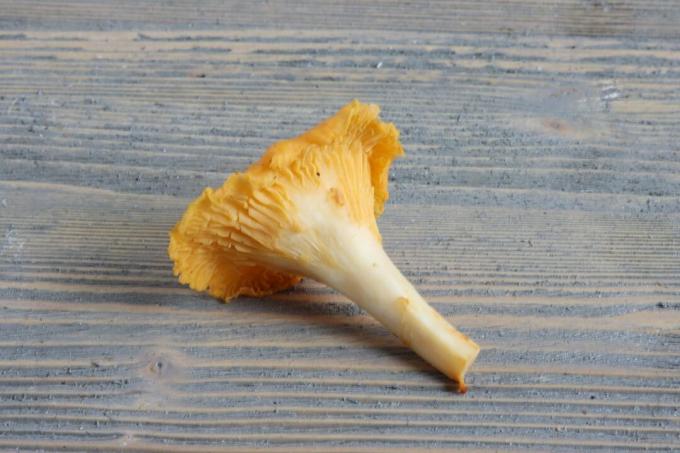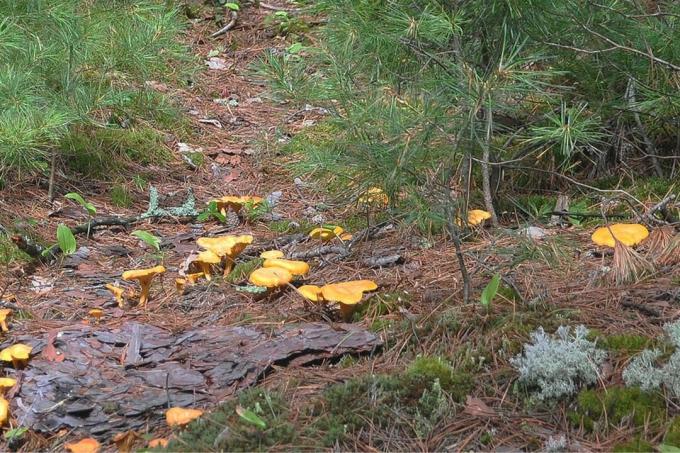
table of contents
- 1. recognize chanterelles
- Find favorite locations
- know about mushroom partnerships
- Make sure the weather is right
- Note risk of confusion
- frequently asked Questions
Chanterelles are one of the most popular edible mushrooms. You can buy them at markets during mushroom season or collect them yourself in the forest. With our tips you will know where to find chanterelles.
In a nutshell
- Harvesting time for chanterelles between June and November
- Found in deciduous and coniferous forests
- mass occurrence possible
- become rare in many regions
- Risk of confusion with the false chanterelle
1. recognize chanterelles
The chanterelle (Cantharellus cibarius) is very popular with mushroom lovers. It is also called Yolk Mushroom, Egg Sponge, Egg Mushroom, Yellow Sponge, Yellow Tube or Rehling.
The tasty edible mushroom belongs to the mushroom family. A characteristic of this fungus family is that the so-called hymenium, the fruit layer, is not on high slats is trained. Low, thick, blunt-edged, ridge-like protuberances line the underside of the hat instead. These ridges are significantly lower and thicker than ordinary slats and run down the stem.
characteristics

- Hat three to four inches wide
- yellow to light yellow hat colour
- weak, later deepening cap curvature
- Cap fleshy, smooth, not shiny
- irregular hat edge
- yolk-yellow, wrinkled ridges connected by transverse ribs
- White or whitish-yellow, firm flesh, breakable into longitudinal fibers
- bare, smooth, filled and thickening stalk at the top
- smells pleasantly fruity
- tastes mild with a peppery finish
Find favorite locations
Older mushroom pickers still remember the times when chanterelles appeared en masse in a suitable location. You only had to go into the forest and you could harvest the popular mushrooms. Today they have become rare.
Real chanterelles grow in sparse deciduous and coniferous forests. In forests with bushy, dense vegetation, on the other hand, the collection baskets remain empty. The soil must be low in nutrients and bases. The sites are often on rotten tree stumps. Chanterelles also like to settle on areas that are hardly overgrown.

know about mushroom partnerships
The real chanterelle is a so-called mycorrhizal fungus. It forms a symbiosis with certain trees. Preferred tree partners include
- common beeches
- spruces
- red beeches
Often you will also find the sites around
- oak trees
- Pine trees
- firs
Make sure the weather is right
When it is muggy and warm in late summer or autumn, the mushrooms shoot out of the ground. The real chanterelle also needs warmth, high humidity and a moist soil. If it gets too cold, it will stop growing.

Notice: The fruiting bodies of the chanterelle appear in Central Europe from June to November.
Note risk of confusion
If you want to consume wild mushrooms, you should be aware of the danger of poisonous varieties. There is no characteristic that alone clearly confirms the edibility of a mushroom. Consult specialist literature. If the fungus to be determined does not match the information given in all its characteristics, it may be a different species. In this case, use the expertise of a mushroom consultant.
The real chanterelle is often confused with the slightly poisonous false chanterelle (Hygrophoropsis aurantiaca).
- unpleasant taste
- no groin fungus
- smaller, more flexible
- odorless
- orange yellow color
- often grows on rotten coniferous wood

Notice: The chanterelle also owes its popularity to the fact that maggots give it a wide berth.
frequently asked Questions
The most common reason mushroom pickers come home empty-handed is the drought this past summer. If there is little precipitation in summer, even the best mushroom weather in autumn can no longer change anything. Chanterelles and co. develop well in muggy and warm weather. Frequent heat thunderstorms in summer herald a productive mushroom season.
Only collect specimens whose hats are at least two centimeters in diameter. Using a sharp knife, cut off the stem just above the ground. Do not tear out the braid, it forms the basis for the formation of new mushrooms in this location.
The causes of the decline in chanterelle occurrences have not yet been fully revealed. The massive gathering of the mushroom pickers has a decisive influence. If even the smallest specimens are taken away and the fungal network is carelessly torn out, no offspring will develop. The extreme heat and drought that has become more frequent in summer in recent years means that the original places where it was found can no longer meet the moisture requirements of the chanterelle.
No, the edible mushroom is not suitable for drying. When dry, it does not soften again, even when it comes into contact with water.
Like all wild mushrooms, the chanterelle can also be contaminated with heavy metals such as mercury, lead and cadmium, as well as with radioactive substances. Therefore, only consume a maximum of 250 grams once a week. Pregnant women and young children should avoid eating chanterelles.



